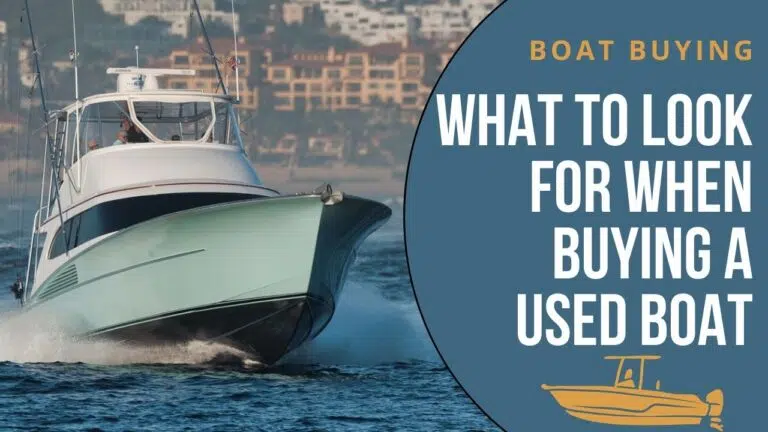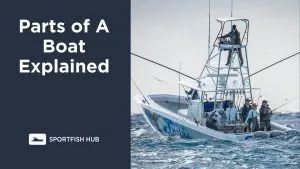Buying a used boat can be an exciting experience, but it can quickly turn into a nightmare if you don’t know what to look for because just one overlooked issue could turn your dream boat into a disappointing lemon.
As a former auction hunter and dealer with years of experience in inspecting and buying used boats, I understand the importance of a thorough inspection process. In this article, I’ll share my expert insights on what you should be looking for when buying a used boat.
Table of Contents
- Key Takeaways
- Used Boat Buying Checklist
- Check the Title and Registration
- Check the Electronics
- Check the Wiring and Electrical System
- Check the Battery or Batteries
- Check the Engine
- Check the Hull
- Check the Trailer
- Checking the Deck of a Used Boat
- Inspecting the Propeller
- Inspecting the Steering Control
- Checking the Lights
- Checking the Appliances
- Checking the Plumbing
- Conduct A Sea Trial
- Hiring a Marine Surveyor
- Negotiating Your Price
- FAQ’s
- How can you tell if a fiberglass hull is bad?
- What to avoid when buying a used boat?
- Should you test-drive a used boat before buying?
- How many hours is too much for a used boat?
- What to look for when buying a boat used in saltwater?
- Conclusion
Key Takeaways
- Documentation and Legalities: Verify the title and registration, and ensure the boat is free of liens.
- Physical Inspection: Examine the boat’s electronics, electrical system, engine, hull, and if applicable, the trailer. Look for signs of damage, wear and tear, and proper maintenance.
- Sea Trial: Test the boat on the water to assess its performance and identify potential issues.
- Professional Assessment: Consider hiring a marine surveyor for a comprehensive evaluation of the boat’s condition and value.
- Price Negotiation: Based on your findings and the marine surveyor’s report, negotiate the price with the seller.
Used Boat Buying Checklist
Below is a used boat buying checklist that you can reference when inspecting the boat:
Check the Title and Registration
Once you find a good used boat that you are seriously interested in buying, one of the most important things you can do (Arguably the most important) is to make sure the seller has the title and registration in hand.
The same goes for a trailer (Although the trailer doesn’t require a title) if one is being purchased with the boat. For these documents, you will need to do the following:
- Check the title information matches what is on the registration and that both match the make/model/year/Hull Identification number of the boat
- Check that the boat’s title is free and clear of any liens
- If you are buying the boat from a Private Party, ensure that the name and address on both documents match their I.D.
Tip: Check with your state or county registration authority to make sure no duplicate titles exist. If someone ordered a duplicate title (for whatever reason) and hands you the original, it’s worthless.
Check the Electronics
With all of the advanced technology in today’s modern boats, it’s more important than ever that you carefully inspect the boat’s electronics to ensure that they are in good condition and fit for use.
It’s also important to check that they’re compatible with the boat’s design and have been installed properly, especially when buying from a private seller!
You should look carefully at any instruments on board or in the cabin, such as the:
- Compass
- GPS System
- Radar
- Radio
- Stereo
- Lights, Nav Lights
Tip: Used Boats always have little quirks, like the order in which something has to be turned on, or it shorts out. Or, if something is too cold or hot, it starts malfunctioning. So, be sure to use/test everything YOURSELF (as you would use it on the water) rather than having its condition shown to you by someone who could manipulate it.
Even after a thorough inspection on your own, where everything seems to be working fine, it may still be worth consulting with an expert before buying the boat just in case there are any problems that you can’t see right away.
Check the Wiring and Electrical System
Right around the time you are checking the electronics, you should also be checking the electrical system and wiring.
The wiring in a boat is incredibly important, especially in newer boats with modern technology like electrical steering. It’s what allows you to operate the engine, lights, and other components of your vessel.
To ensure that the wiring on your boat is in good condition, check for the following:
- Frayed wires
- melted wired
- loose connections
- corrosion
If you find any of these problems on a quick personal inspection, it’s likely that there are other potentially more serious problems in the system as well, so be sure to look carefully when inspecting your boat.
Tip: Get a Multi Meter to check that the voltage and current are consistent and as they should be.
Check the Battery or Batteries
Next, we are on to checking the Boat’s Batteries. Some boats will only have one battery and others can have 10. Nevertheless, the process is the same.
Start by checking the terminals; make sure they are clean and tight with no visible corrosion or oxidation from salt water. A small amount isn’t out of the ordinary, but it would raise questions with me about how the owner cared for his boat if he didn’t clean that off before showing people the boat.
Next, check your cables: make sure they are securely connected at both ends and have no evidence of heat damage or excessive wear.
Lastly, check out your battery case itself; Do you see any cracks or leaking? Also, be sure that the case is secured tightly down into the batteries tray. When a battery is loose on a boat, it can shift suddenly, causing a short that could actually start a fire.
Check the Engine
Checking the engine is where you can make or break your new boat because it’s by far the most expensive component. Although we HIGHLY encourage you to seek an inspection from a mechanic or marine surveyor, let’s cover how you can check a boat engine yourself if you have no other choice:
- Check the Engine Compression: Testing the compression on a boat motor is about determining if the piston rings still have a good seal in the cylinder. The amount of compression can vary so refer to the specific manual for the engine you are testing
- Check the engine oil: Make sure the oil level is where it belongs on the dipstick and that the oil is clean. It’s a good idea to get some on your hands to feel for any particles or grit. You also want to make sure it doesn’t have a milky color, which is an indication of moisture. If there is moisture, you simply aren’t buying this boat.
- Belts and Hoses: Check belts and hoses for cracks or loose connections.
- Check the Fuel Filter: A fuel filter prevents sediment from getting into your fuel tank; if there are large chunks of sediment in the filter, it could mean some serious junk is in the fuel tank. This doesn’t mean it passed through to the engine, but it does count against how an owner cared for his boat, which should always be factored in during an inspection.
- Take a look at spark plugs: You’re looking for a lot of dark deposits at the top of the plug or cracks in the plugs themselves. Once again, spark plugs are not expensive, but bad spark plugs point towards someone who did not carefully inspect their own boat very often.
- Ask for Maintenance Records: On some smaller boats sold by private sellers, they might very well have done a lot of maintenance themselves, so; no maintenance records. But it certainly is something you should always ask for anyway.
Checking the Lower Unit
The lower unit is an extremely critical part of outboard motors, and it’s often the most neglected, especially for boats kept in the water where they are hard to maintain.
Lower units have moving parts, therefor they need lubrication, and that means lower unit oil. The recommended interval for changing is 100 hours.
This is absolutely a fluid you need to check because it’s the one fluid the seller might not have thought to check.
Check the Hull
Hulls are a very expensive part of the boat, and are literally what separate you from being in the water, so you want to make sure that this boat’s hull is in good shape.
In all honesty, the best way to do this is by having a professional haul your boat out of the water and inspect it. But, if that isn’t in the budget or if you’re buying from a private seller, here are some things you can look for yourself (Above the water line at least):
- Check for cracks in the fiberglass: Spider web or small stress cracks are common in a used boat. What you are looking for here are serious cracks, and if there are any SERIOUS cracks or other damage, they should be repaired before purchase.
- Check the hull for blisters on top of the gel coat: These blisters indicate water damage that could lead to dry rot or delamination (peeling).
- Look closely at where welded joints meet the hull— If they have been repaired with epoxy or silicone sealant (as opposed to being welded), then there may be a weak spot in your boat’s structure that could lead to problems later on down the road.
- Check the transom carefully (outboard motors): Obviously, the weight of outboard engines is going to add stress to any transom and the hull, and this is an area you will want to carefully inspect as it is the most likely spot on a used boats hull to have damage
- Check for Repairs: Repairs on a used boat are inevitable, but look for repairs that were done sloppily or that were large. These could indicate more happened to the boat than just normal wear and tear.
Check the Trailer
A boat trailer is a huge investment, especially when you need it to move your boat, so it’s important to make sure the one you’re looking at has been properly maintained. That means checking the following:
- Safety Inspection: If your state requires a safety inspection, ensure the inspection is up to date.
- Tires: Trailer tires tend to sit a lot so they might have great tread but be completely dried out. Also look for bubbles and any other signs of damage.
- Lights: Check that all the trailer lights (including marker lights) work properly. (They rarely do)
- Wheel Bearings: Remove the caps covering the wheel bearings and look for a milky white color to the grease or grease with a silver color to it. Silver coloring indicates damage and a milky white grease indicates moisture has penetrated the bearing hubs.
- Trailer hitch: Check around the hitch for more signs of SERIOUS corrosion. Minor corrosion is expected.
Checking the Deck of a Used Boat
The condition of the deck can be an indication of how well the boat has been maintained, as well as its overall age and wear. If a used boat is showing signs of water damage on its deck, it may indicate poor storage practices or poor maintenance by previous owners.
Checking for cracks, holes, or soft spots in the deck involves looking at all surfaces — inside and out — including places where seams join together as well as areas near hatches and other opening points (you may want to bring a flashlight with you if possible). If any cracks are found, they should not only be noted but measured with either paper or tape measure from end-to-end so that an accurate picture can be formed about what kind(s) work might need to be done down the road when buying something new.
As with other parts of the boat, small cracks like spyder cracks are to be expected in older boats, so focus on either an excessive amount of small cracks or large cracks.
Inspecting the Propeller
The propeller works to move your motorboat, so it is of paramount importance that it functions correctly. However, inspecting the propeller can be dangerous, so make sure the boat’s battery is disconnected from the engine before putting yourself anywhere near it.
Inspecting the Steering Control
The steering control system is one of the most important parts of a boat. It starts with the steering wheel. The wheel itself usually doesn’t suffer from any issues, but you’ll want to take a look at it anyway.
Electronic steering is all the rage right now and will continue to replace traditional hydraulic steering systems.
In our opinion, it is CRITICAL that you have a professional inspect the electronic steering system before purchase, especially if there is no warranty involved.
Personal story: I was out with a professional fishing team on a brand new boat, and while cruising at a comfortable 35mph in autopilot, the electronic steering decided the boat should turn hard to the left. Luckily, we were not going very fast and everyone was properly seated. No matter what we did from that point on when the throttle was engaged, the motors turned hard to port. We had to drive 30 miles home using only the joystick because that’s the only way the motors would behave normally.
Checking the Lights
Even if you don’t plan on using your boat at night, you still have to have properly functioning boat lights. Check all the lights to ensure they are working correctly.
Checking the Appliances
Larger boats may have appliances like fridges, stoves, and even microwaves. Make sure these are in working order, as they can be expensive to replace.
Checking the Plumbing
A boat with bathroom and kitchen facilities will usually have a freshwater system and a blackwater system. Check these systems to ensure they are functioning correctly.
Conduct A Sea Trial
A sea trial is your chance to get out on the water and see how a boat performs. It’s also an opportunity to check for any flaws or defects that the seller may have overlooked. During a sea trial, you should spend time checking every aspect of your potential purchase:
- Make sure all systems are in good working order and fully functional. For example, if there is a generator, ensure that it works as advertised and produces enough power for your purposes (don’t expect it to run all appliances at once).
- Check the engine’s performance on both idle speed and full throttle—this will tell you how well the engine has been maintained over time. If there are any issues with smoothness or acceleration, and ask why they were not addressed before selling it off (there could be hidden mechanical problems).
Hiring a Marine Surveyor
Hiring a surveyor to inspect a used boat is an essential first step to ensuring any boat you’re looking at is in good condition.
A Marine surveyor won’t just reveal issues; they will also tell you which issues need fixing right away and how much they will cost. That is essential when you are negotiating your price!
Some very important reasons why you should hire a professional surveyor:
- A lot of lenders require a boat to be surveyed.
- A lot of insurance companies require a boat to be surveyed.
- A surveyor can determine how much a used boat is actually worth.
Negotiating Your Price
- Many boat owners are not realistic about price: People are more likely to sell a car at a real-world value, but when it comes to selling boats, 9 times out of 10, they think it’s worth more than it actually is because they love it. Don’t let this get to you.
- Asking for a lower price: Everyone offers less than the asking price, and sellers typically factor that in when they first advertise a boat. That being said, used boats aren’t like used cars- If you miss this one, there are likely not five more available down the road. So, be sure to try and get your deal, but don’t ever risk losing a good boat because you were trying too hard to get a good deal.
- Price is too high: Don’t be afraid to walk away if the price isn’t right or if the seller isn’t being fair about reducing their price to cover necessary repairs. If the seller won’t meet your asking price, leave and look elsewhere for another boat. Many times they will call you back, but sometimes they won’t because
FAQ’s
How can you tell if a fiberglass hull is bad?
Signs of a bad fiberglass hull may include cracks, blisters, or discoloration. Soft spots on the hull can indicate delamination, a serious issue where the layers of fiberglass separate.
What to avoid when buying a used boat?
Avoid buying a used boat without thoroughly inspecting it or having it inspected by a professional. Be wary of boats with extensive damage or signs of poor maintenance. Also, avoid sellers who cannot provide a clear history of the boat.
Should you test-drive a used boat before buying?
Yes, it’s highly recommended to test-drive a used boat. This allows you to check the boat’s handling, engine performance, and overall condition on the water.
How many hours is too much for a used boat?
There’s no hard and fast rule, but a boat with more than 1,000 hours might be considered high. However, the engine’s maintenance and repair history is often more important than the number of hours it’s been used.
What to look for when buying a boat used in saltwater?
Saltwater can cause corrosion, so check the boat carefully for signs of rust or corrosion. Pay special attention to the engine, electrical systems, and any metal parts. Also, ask about the boat’s maintenance history, as regular cleaning and maintenance are crucial for saltwater boats.
Conclusion
In conclusion, buying a used boat can be exciting. However, it is important to do your research and thoroughly inspect the boat before making a purchase. This can help ensure that you are getting a quality boat that will meet your needs and last for many years to come. It is also essential to consider the overall costs of owning a boat, including maintenance, repairs, and storage. With the right approach, you can find the perfect used boat to suit your needs and enjoy many years of fun on the water.












